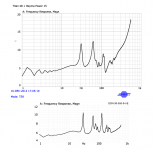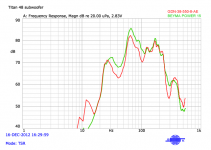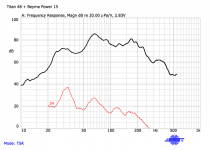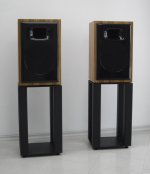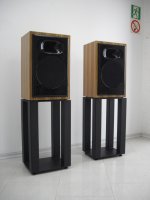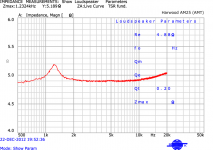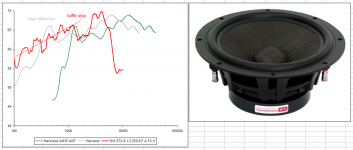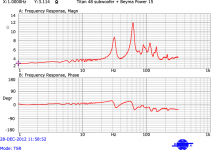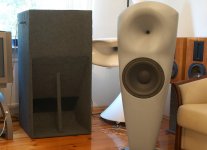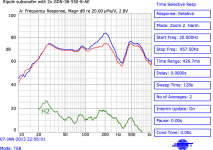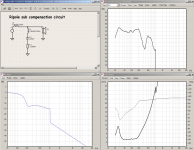Here is a still-drying final coat next to stock (and the speaker it's used in, with my OSWGs)
Took about 10 thin coats over the weekend to get it there, but it's overall a pretty thin coating. Based upon impedance sweeps, I added a little extra to one driver, which got them very close in electrical performance.
A slight reduction of frequency of the impedance peaks (about 5%) and damping of both peaks, especially the higher freq peak (which also fell from 12.5 ohms to 10.5) was the electrical result of the mod.
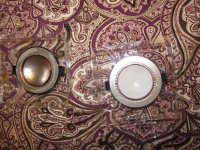
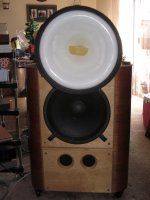
Took about 10 thin coats over the weekend to get it there, but it's overall a pretty thin coating. Based upon impedance sweeps, I added a little extra to one driver, which got them very close in electrical performance.
A slight reduction of frequency of the impedance peaks (about 5%) and damping of both peaks, especially the higher freq peak (which also fell from 12.5 ohms to 10.5) was the electrical result of the mod.


Correction about Horn Requests
I just found this historical piece on the formation of the Japanese horns driver industry and how Goto Split off from YL wanting to pursue higher Fidelity for home use. The important point being was my monumental **** up of requesting. Exponential profiles ans stating that goto used these. Here is a Cut from the article"
Goto did find out as well, that horns had to be short, to have low distortion and a correct sound. So , contrary to all others, he choose the hyperbolic profile. This profile has a important characteristic :
The impedance is constant almost from the cutoff Fc frequency, contrary to the exponential profile. This was the determinant factor of the choice of Goto. Whether current goto horns are expo or hyperbolic I don't know. I will do further reading and working on buying a pair too try the different drivers I am collecting. I still remain fascinated with the look of goto horns and from what I have read. Given the correct drivers. They could be suitable for my needs. I will pursue this with you further when I understand more.
Fatbattery - isn't it Tractrix: 110, 200, 350, 600, 1000 what you look for?
I just found this historical piece on the formation of the Japanese horns driver industry and how Goto Split off from YL wanting to pursue higher Fidelity for home use. The important point being was my monumental **** up of requesting. Exponential profiles ans stating that goto used these. Here is a Cut from the article"
Goto did find out as well, that horns had to be short, to have low distortion and a correct sound. So , contrary to all others, he choose the hyperbolic profile. This profile has a important characteristic :
The impedance is constant almost from the cutoff Fc frequency, contrary to the exponential profile. This was the determinant factor of the choice of Goto. Whether current goto horns are expo or hyperbolic I don't know. I will do further reading and working on buying a pair too try the different drivers I am collecting. I still remain fascinated with the look of goto horns and from what I have read. Given the correct drivers. They could be suitable for my needs. I will pursue this with you further when I understand more.
Any updated on the SEOS-24?
I just got measurements. It's roughly 15" x 24.3" with a minimum crossover at 500hz. 1.4" or 1.5" intake.
A little experiment with Titan 48 subwoofer:
Titan48 - YouTube
driven with Beyma Power 15 and GDN-38-550-8-AE (Qt=0.9). Probably air leaks visible on impedance plot.
Titan48 - YouTube
driven with Beyma Power 15 and GDN-38-550-8-AE (Qt=0.9). Probably air leaks visible on impedance plot.
Attachments
Not yetI think end of January.
Thanks for the update, i'll be waiting very impatiently.
Sent from my DROID3 using Tapatalk 2
My friend did near field monitor based on AMT AM35, Wavecor midbass and STX carbon woofer (very stiff diaphragm). Today I made measurements using 2012 analyzer and exported to XY ASCII - it only requires rearrange in Excel to FRD format. Some data for educational purposes below.
Attachments
Last edited:
Simply just beautiful!FP10 with wood veneer that goes to Germany next week.
PA horn sub lacks fullness. I did quick and dirty ripole sub and I like results very much (actively driven) but midrange peak must be equalized completely and everything above removed. At the moment I don't have coils above 4mH for compensation circuit - better is 4,5mH. Bass is just right in some places just thinner.
Ripole sub - YouTube
Ripole sub - YouTube
Attachments
- Home
- Group Buys
- Waveguides and horns
